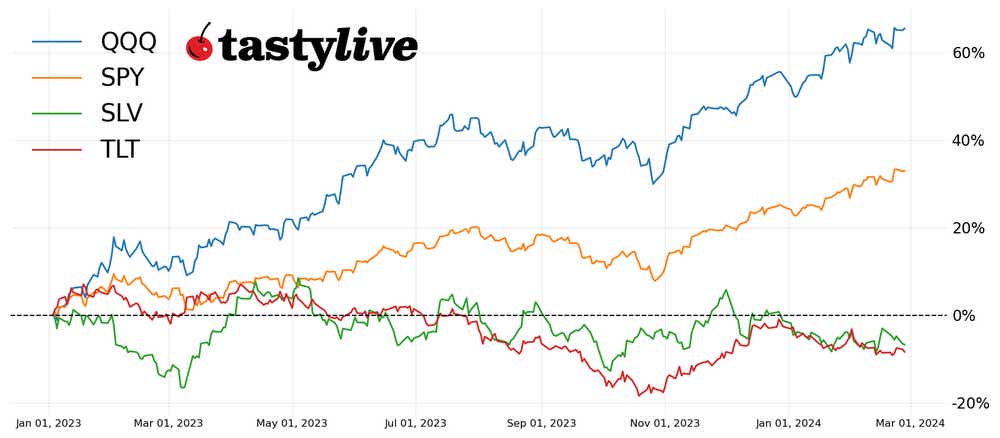Top 10 Stocks to Watch: March 2024

Top 10 Stocks to Watch: March 2024
After months of bull markets, March’s price action may be choppy
- Price action in the e-mini remains near all-time highs, moving from below $4,900 to below $5,100 in February, indicating a strong bullish bias.
- The S&P has been in a bull market trend since November 2023, but the continuation of this trend into March is less certain due to the recent three-month bullish period.
- March's market could be choppy, with bulls pushing prices higher and bears starting to challenge the all-time highs; investors are advised to hedge against potential downturns but maintain their overall strategy.
Last month, our market update began by stating that we were near all-time highs. Today, price action remains near all-time highs more than 100 points higher, in the e-mini. February started below $4,900, and we are currently bouncing below $5,100. This move during February indicates strong bullish bias.
That being said, we have had a bull market trend in the S&P since November of 2023. If February’s price action had not been at the end of a nearly three-month bull trend, I would be more confident saying that the bull trend will continue from where we are now.
But that is not the case, and February’s price action did occur after two months of bullish price action so I am more confident saying that March’s price action will be choppy. Bulls will continue to push higher as much as possible, and bears are going to start chipping away at these all-time highs.
Hedge against a down move if you think that is the correct play to make for your account, but in general remain consistent and stick with your strategy.
A note on earnings trades
To capture the bulk of the volatility of earnings announcements, earnings trades are often executed either the day before or on the day of the earnings announcement. However, earnings trades can also be placed days or weeks before an earnings event, which could lead to early profit taking.
Alternatively, placing a trade shortly after an earnings announcement can be a strategic choice to circumvent the binary nature of the event. Evaluate each trade in a way that allows you to execute the position that matches your strategy.
If you're considering a trade going into an earnings event, one approach is to initiate the position in the monthly options contract that follows the earnings event. This strategy offers flexibility. Should you need to defend your position—perhaps because of unexpected market movements—you have the choice to 'roll' it out to the subsequent monthly options. Rolling out the position in this enables you to extend its duration and potentially collect more premium, providing a buffer against market volatility.

Top 10 stocks to watch in March 2024
- Target (TGT) – 3/5 - Before the open
- Nordstrom (JWN) – 3/5 - After the close
- JD.com (JD) – 3/6 - Before the open
- Marvell Technology (MRVL) – 3/7 - After the close
- DocuSign (DOCU) – 3/7 - After the close
- Gap (GPS) – 3/7 - After the close
- XPeng (XPEV) – 3/19 - Before the open
- Micron Technology (MU) – 3/20 - After the close
- Nike (NKE) – 3/21 - After the close
- FedEx (FDX) – 3/21 - After the close
1. Target (TGT)
TGT sells a variety of products, including household essentials and apparel, in the consumer discretionary sector and general merchandise stores industry. TGT is currently up 6.24% year-to-date. Its current IVR is 61.6, with March IVx at 46.9, April IVx at 34, and its liquidity is rated 3 out of 4 on the tastytrade platform.
Earnings positions can be placed in March contracts. Strangles and iron condors set up well for a neutral position. Spreads can be set up for any directional assumptions. Calendar and diagonal spreads are also in play.
2. Nordstrom (JWN)
JWN sells clothing, shoes and accessories for men, women and children in the consumer discretionary sector and department stores industry. JWN is currently up 18.41% year-to-date. Its current IVR is 59.9, with March IVx at 82.6, April IVx at 62.6, and its liquidity is rated 3 out of 4 on the tastytrade platform.
JWN is a smaller-sized product, so smaller accounts could consider undefined risk positions. Strangles, directional spreads and calendarized spreads can be set up with a decent credit received to buying power used ratio.
3. JD.com (JD)
JD operates an e-commerce platform and provides retail services in China, in the consumer discretionary sector and internet & direct marketing retail industry. JD is currently down 13.52% year-to-date. Its current IVR is 87.1, with March IVx at 70.1, April IVx at 59.7, and its liquidity is rated 4 out of 4 on the tastytrade platform.
JD is like JWN in that it is a smaller product, and smaller accounts can consider undefined risk positions. Strangles and directional spreads set up well. Calendarized spreads are more difficult here because the difference in IVx between monthly contracts is smaller than JWN.
4. Marvell Technology (MRVL)
MRVL designs and markets semiconductors in the technology sector and semiconductors industry. MRVL is currently up 18.58% year-to-date. Its current IVR is 83.9, with March IVx at 71.4, April IVx at 53.8, and its liquidity is rated 3 out of 4 on the tastytrade platform.
MRVL is very volatile and the credit to buying power received ratio is low. This is helpful for collecting more credit but means you will likely have your position tested more often. Strangles, iron condors, directional spreads,and calendarized spreads are all in play.
5. DocuSign (DOCU)
DOCU provides electronic signature technology and digital transaction management services in the technology sector and software—application industry. DOCU is currently down 11.46% year-to-date. Its current IVR is 50, with March IVx at 70.9, April IVx at 53, and its liquidity is rated 2 out of 4 on the tastytrade platform.
DOCU is a smaller-sized product, and smaller accounts can consider undefined risk positions. Strangles, iron condors, directional spreads and calendarized spreads are all in play.
6. Gap (GPS)
GPS sells clothing, accessories and personal care products in the consumer discretionary sector and apparel retail industry. GPS is currently down 4.76% year-to-date. Its current IVR is 65.9, with March IVx at 88.5, April IVx at 63.1, and its liquidity is rated 3 out of 4 on the tastytrade platform.
GPS is a smaller-sized product, and smaller accounts can consider undefined risk positions. Strangles, iron condors, directional spreads and calendarized spreads are all in play. A naked put or naked call could also be an option if you are comfortable with the risk and have a directional assumption.
7. XPeng (XPEV)
XPEV manufactures and markets electric vehicles in China in the consumer discretionary sector and automobile manufacturers industry. XPEV is currently down 34.62% year-to-date. Its current IVR is 62.4, with March IVx at 85.6, April IVx at 83, and its liquidity is rated 4 out of 4 on the tastytrade platform.
XPEV is not as easy to trade as the rest of the symbols on this list. For that reason, sticking to directional spreads or iron condors make the most sense. However, XPEV currently has high IVR and there is opportunity to take advantage of it.
8. Micron Technology (MU)
MU manufactures memory and storage solutions in the technology sector and semiconductors industry. MU is currently up 9.07% year-to-date. Its current IVR is 65.4, with March IVx at 38.9, April IVx at 43.8, and its liquidity is rated 4 out of 4 on the tastytrade platform.
MU currently has a good environment for selling premium. Strangles, iron condors, and directional spreads are all in play. MU currently provides a decent credit received to buying power used for undefined risk positions.
9. Nike (NKE)
NKE designs and sells athletic footwear and apparel in the consumer discretionary sector and footwear and accessories industry. NKE is currently down 3.16% year-to-date. Its current IVR is 49.7, with March IVx at 25.6, April IVx at 33.6, and its liquidity is rated 3 out of 4 on the tastytrade platform.
NKE is a medium-sized product, so medium sized accounts could consider undefined risk positions. NKE currently has a good environment for selling premium. Strangles, iron condors and directional spreads are all in play.
10. FedEx (FDX)
FDX provides transportation, e-commerce and business services in the industrials sector and integrated freight and logistics industry. FDX is currently down 3.73% year-to-date. Its current IVR is 42.1, with March IVx at 22.4, April IVx at 28.8, and its liquidity is rated 3 out of 4 on the tastytrade platform.
FDX is a larger-sized product, so only large-sized accounts should consider undefined risk positions. Most accounts will want to define their risk. Iron Condors and directional spreads set up well. Since FDX reports earnings later in March, it may be worth waiting until the earnings date is nearer to put on an earnings trade.
Ryan Sullivan is an active options and forex trader and programming producer for the tastylive network.
For live daily programming, market news and commentary, visit tastylive or the YouTube channels tastylive (for options traders), and tastyliveTrending for stocks, futures, forex & macro.
Trade with a better broker, open a tastytrade account today. tastylive, Inc. and tastytrade, Inc. are separate but affiliated companies.
Options involve risk and are not suitable for all investors. Please read Characteristics and Risks of Standardized Options before deciding to invest in options.